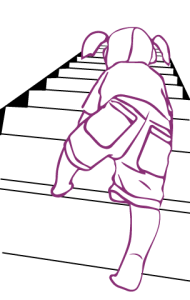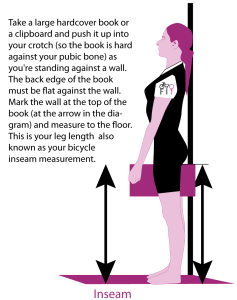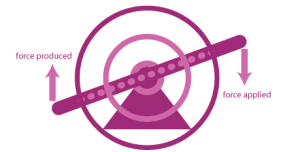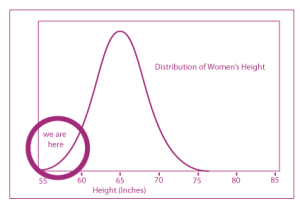After 4 years of riding my Rodriguez, I put 155 mm crank arms on my bike hoping I’d found the one bike fit element I’d overlooked that would change my performance. After preaching endlessly about 650c wheels and shorter top tubes, I was still looking for a way to be more comfortable on my bike.
Why? Because, the more you ride, the more those little things that aren’t just right will turn into big things. Big things can make you so uncomfortable that you stop riding.
Do you remember climbing the stairs when you were a little kid?
Remember the work it took to lift your little feet up so high to climb them? Well, one day after riding up a category 2 climb (that’s racer’s code for steep and long), I realized that my knees were coming up too high at the top of each pedal stroke. The steeper the incline, the more the problem was exaggerated. When I watched other riders, they weren’t struggling like me. My son even said he noticed my knees wobbling as my feet approached the top of the crank. Intuitively, I felt like my body was longing to make smaller circles. A little thing had become a big thing.
Much research and discussion ensued. Some said ‘With smaller cranks you increase your cadence because you spend less time making one pedal revolution’, but others countered with ‘This won’t necessarily increase your performance because you lose leverage.’
The prevailing opinion went something like this: If you are a pedal masher then longer crank arms are better; but if you like to spin, shorter crank arms will give you the edge you’re looking for. These were discussions about whether to increase crank length by no more than 5mm. (The standard size crank arms are 170, 172.5 and 175 mm).
Average sized people couldn’t seem to wrap their head around what I was getting at. “This isn’t just a physics problem,” I said repeatedly, “This is also a biomechanics problem.” Remember, bikefit is based on proportionality. Petite riders are on the left side of the bell curve.
For all my training alongside family members, I couldn’t explain my lack of improvement. I wanted to go faster–especially up hills. I wanted to spin better. If I wasn’t concentrating on form, I would feel dead spots in my stroke…and the chain and crank would clunk as if trying to catch up… with what… I couldn’t figure out. I wanted to feel less fatigued after a long ride. I wanted my legs to hurt less and show signs of all the hard work I had been expending. I wanted to see curves on the tops of my thighs.
My muscles weren’t developing because they weren’t being used properly. I felt as though I was relying on my tendons and ligaments with each crank revolution almost as much as the belly of my muscles. Was I hampering my athletic development? Was I risking a sprain or other injury as I repeatedly exceeded the normal range of motion of my knees?
According to Andy Pruitt, founder of the Boulder Center for Sports Medicine, you can hurt yourself if your cranks are too long because the compressive and shear forces in the knee joints “go up exponentially,” with a sharper knee bend.
And of course my family thought I was a consumer driven nutcase with an expensive and serious case of the, “I wants.”
I even went to Interbike to try and find the answer.
There was no indication that Campagnolo or Shimano would listen to a petite, middle aged woman with a thyroid problem, a tiny website, and a big mouth.
I had all but given up when I ran into Andrew Weber from bikefit.com who suggested I try significantly shorter (as in 130 mm) crank arms– a full 40mm shorter than what I was riding. Of course it would increase my spin– and I would look like a kid on a tricycle. His recommendation to decrease the diameter of my circle by 3.14 inches sent me into a…tail…spin.
Where would I get shorter crank arms?
In recent years, emphasis has been on the development of electronic shifting, a technology requiring batteries that unnecessarily add to the earth’s massive landfill. At the same time, little has been done to expand crank arm length options. Creating a system of interchangeable crank arms to accommodate different sized riders would make cycling more accessible, enjoyable, satisfying and more practical for a range of daily uses while improving our planet’s ecology. Hello … Campagnolo, Shimano and SRAM… we’re waiting!
Only a few manufacturers are producing crank arms less than 170mm. If you are around 5’2″ the crank arms on your bike should definitely not exceed 165mm. Luckily, these are available from Shimano. If you are shorter, then your crank arm lengths should decrease in proportion to your height. I am 5′ 1/2″ with a 75.2 cm inseam and am now riding 155 mm crank arms. Finding them has been a challenge.
Thank you, Lennard Zinn. If I’m the short and small gal of cycling, Lennard is the big and tall guy.
He also happens to be sensitive to the importance of correct crank arm length and manufactures (in the U.S.) custom sizes from 130 mm for petite folks up to 220mm for the tall guys. According to Lennard, your ideal crank length is in the range of 21% – 21.6% of your leg length. This measurement is not the inseam of your pants, but rather a measurement from the floor to the pubic bone with your feet 2 inches apart. 
Origin-8 manufactures lower end versions for under $100./set. This is especially reasonable if you would like to experiment with different lengths before making a larger investment.
Even so, the cost of retrofitting your bike can be upwards of $400. (in parts and labor). Zinn’s higher end cranks go for $459. (and that doesn’t include the bottom bracket). If you have Campagnolo components, it is even more expensive to retrofit because of compatibility issues and for that reason alone you may want to make sure you outfit with Shimano components when you buy a new bike.
Now you can see why it is wise to consider crank arm length at the same time you purchase your frame. As an aside, it is important to also consider your seat and bar heights when changing your crank length. In other words, if you decrease your crank arm length by 10mm, you will have to increase your seat height by the same amount as well as handlebar height. You may need to reassess the fore/aft position of your saddle as well.
If you are a serious competitor, then an extensive fitting by a qualified bikefitter who can take exact measurements while assessing the condition of your joints (flexibility, prior injury, etc.) is warranted. Please be advised that both the level one Trek and Specialized bike fitting programs, which I attended, did not address crank arm length. However, without the extensive and expensive bike fitting, using Zinn’s formula might be the answer.
I would be remiss by not also mentioning Peter White who uses a slightly different formula to determine crank arm length. Peter uses a formula that is 18.5% of the distance from the top of the femur to the floor. He prefers to use crank arms from Specialties TA, a French company who manufactures them in these sizes: 150, 155, 160, 162.5 and 165 mm. He may be the best retailer for this particular brand. He also believes that the best approach is to try different lengths until you find the one that works best for you.
As usual, trying to come up with one exact formula that works for everyone is futile. Everyone’s body is different with a different history and different riding style.
As a petite woman cyclist, I’m here to encourage you to look at the basic proportionality of your body on your bike and realize that crank arm length is a primary consideration in proper bike fit. Since installing 155mm crank arms on my bike, I have not dropped my chain and the dead spots in my stroke are gone. I can ride with my hands off of the handlebars because I am not exceeding the range of motion in my knees, therefore I have more stability and control which also makes it easier to get out of the saddle. Though my endurance has significantly improved, I am still working on that category 2 climb, but am finding it easier with each attempt.
Crank arm length is not just an issue for petite women. My very best friend, a cyclist, Chiropractor and Acupuncturist is 5′ 5 1/2″ tall. Her inseam is 78 cm and she has just changed her crank arms from 170 to 165 mm and reports an instant improvement in her performance. “No more dead spots.” — just thought I should let you know– especially if you are 5’3″ or taller and think this article doesn’t apply to you.
Update: I recently took the time to determine if less is more, or if one can really approach the point of diminishing returns when it comes to crank arm length. After installing 145 mm crank arms, it only took me one ride to realize they were too short. How did I know? I lost all leverage when climbing, especially while off the saddle.


